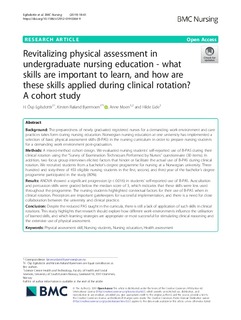Revitalizing physical assessment in undergraduate nursing education - what skills are important to learn, and how are these skills applied during clinical rotation? A Cohort Study
Journal article, Peer reviewed
Published version
Permanent lenke
http://hdl.handle.net/11250/2640956Utgivelsesdato
2019Metadata
Vis full innførselSamlinger
Sammendrag
Background:The preparedness of newly graduated registered nurses for a demanding work environment and carepractices takes form during nursing education. Norwegian nursing education at one university has implemented aselection of basic physical assessment skills (B-PAS) in the nursing curriculum in order to prepare nursing studentsfor a demanding work environment post-graduation.Methods:A mixed-method cohort design. We evaluated nursing students’self-reported use of B-PAS during theirclinical rotation using the“Survey of Examination Techniques Performed by Nurses”questionnaire (30 items). Inaddition, two focus group interviews elicited factors that hinder or facilitate the actual use of B-PAS during clinicalrotation. We recruited students from a bachelor’s degree programme for nursing at a Norwegian university. Threehundred and sixty-three of 453 eligible nursing students in the first, second, and third year of the bachelor’s degreeprogramme participated in the study (80%).Results:ANOVA showed a significant progression (p< 0.016) in students’self-reported use of B-PAS. Auscultationand percussion skills were graded below the median score of 3, which indicates that these skills were less usedthroughout the programme. The nursing students highlighted contextual factors for their use of B-PAS when inclinical rotation. Preceptors are important gatekeepers for successful implementation, and there is a need for closecollaboration between the university and clinical practice.Conclusion:Despite the reduced PAS taught in the curricula, there is still a lack of application of such skills in clinicalrotations. This study highlights that research should explore how different work environments influence the utilisationof learned skills, and which learning strategies are appropriate or most successful for stimulating clinical reasoning andthe extensive use of physical assessment
Beskrivelse
Open Access This article is distributed under the terms of the Creative Commons Attribution 4.0 International License which permits unrestricted use, distribution, and reproduction in any medium, provided you give appropriate credit to the original author(s) and the source, provide a link to the Creative Commons license, and indicate if changes were made.

